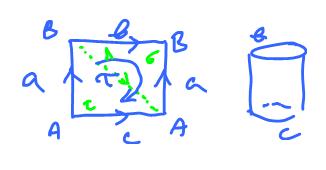This site is being phased out.
Homology as a vector space
Redirect to:
Given a cell complex $K$. A chain is then a "formal" linear combination of finitely many oriented cells.
Now, what about the set of all chains?
To make this more specific, let's concentrate on real chains, i.e., one with real coefficients.
Let $C_k(K)=C_k(K;{\bf R})$ denote the set of all such chains: $$C_k(K) = \left\{ \displaystyle\sum_i s_i \sigma_i \colon s_i \in {\bf R}, \sigma_i {\rm \hspace{3pt} is \hspace{3pt} a \hspace{3pt}} k{\rm -cell \hspace{3pt} in \hspace{3pt}} K \right\}$$ So, $C_k(K)$ be the set of all $k$-chains, i.e., chains "made" of $k$-cells only ($0$ is included too).
We define addition of chains by adding the coefficients of each cell: $$\begin{array}{l} A = \displaystyle\sum_i s_i\sigma_i, \\ B = \displaystyle\sum_i t_i \sigma_i, {\rm \hspace{3pt} then} \\ A + B = \displaystyle\sum_i (s_i + t_i)\sigma_i. \end{array}$$
Theorem. $C_k(K)$ is a vector space with a basis consisting of the $k$-cells of $K$.
Proof. Easy. $\blacksquare$
Clearly, the boundary operator is a linear operator defined on this vector space. Then the notation for the chain complex of $K$ is: $$\{C(K), \partial \},$$ where $$C(K)=\bigcup _k C_k(K).$$
Note: A somewhat more advanced way of looking at the chain complex is as the product of these vector spaces: $$C(K) = \ldots \times C_k(K) \times C_{k-1}(K) \times \ldots \times C_1(K) \times C_0(K).$$
To be careful one has to split the boundary operator along the dimensions: $$\partial_k \colon C_k(K) \rightarrow C_{k-1}(K).$$
Thus we have a sequence of vector spaces and linear operators: $$\ldots \rightarrow C_k(K) \rightarrow C_{k-1}(K) \rightarrow \ldots \rightarrow C_1(K) \rightarrow C_0(K) \rightarrow 0.$$
A chain is called a cycle if its boundary is $0$: $$\partial \tau = 0.$$
Theorem. The cycles form a subspace $Z_k(K)$, the $k$-cycle group, of the chain group $C_k(K)$ which is the kernel of the boundary operator: $$Z_k(K) = {\rm ker \hspace{3pt}} \partial.$$
A $k$-chain is called boundary if it's the boundary of a $(k+1)$-chain: $$\tau = \partial \sigma.$$
Theorem. The boundaries form a subspace $B_k(K)$, the $k$-boundary group of the chain group $C_k(K)$ which is the image of the $(k+1)$-chain group under the boundary operator: $$B_k(K) = \partial (C_{k+1}(K)).$$
Theorem. Every boundary is a cycle, in other words: $$\partial \partial = 0.$$
Proof. Leter. $\blacksquare$
So, the boundary group is a subspace of the cycle group.
Now homology is an equivalence relation. What is its algebraic meaning?
Consider the boundary group of the cylinder:
These are the chain groups generated by the cells: $$C_2(K) = {\rm span}\{ \tau \},$$ $$C_1(K) = {\rm span}\{a, b, c \}.$$
Next, these are the cycle group and the boundary group: $$Z_1(K) = {\rm span}\{b, c \}, {\rm \hspace{3pt} and}$$ $$B_1(K) = {\rm span}\{ \partial \tau \} = {\rm span}\{a + b - a - c \} = {\rm span}\{ b - c \}.$$
This last part is understood as $$b - c \sim 0,$$ $$B - A \sim 0.$$
Or:
Algebraically, $$x \sim y {\rm \hspace{3pt} iff \hspace{3pt}} x - y \in B_1(K).$$
See Quotients of vector spaces.
Thus the homology group is a vector space that is the quotient of the cycles over the boundaries: $$H_1(K) = Z_1(K) / B_1(K).$$
For the cylinder: $$H_1(K) = {\rm span}\{b, c \} / {\rm span}\{ b - c \} = {\rm span}\{ b + span\{ b - c \} \}.$$
In particular, its first Betti number is $b_1=1$.
Let's consider the torus:
$$\begin{array}{l} Z_1(K) = {\rm ker \hspace{3pt}} \partial = {\rm span}\{a, b \}, \\ B_1(K) = {\rm span}\{ \partial \tau \} = {\rm span}\{a + b - a - b \} = {\rm span}\{0 \} = 0, {\rm \hspace{3pt} so} \\ H_1(K) = {\rm span}\{a, b \} / 0 = {\rm span}\{a, b \}. \end{array}$$
In particular, its first Betti number is $b_1=2$.
For more examples of this kind see Homology in dimension 2.
Recall that, in general, the $k$-th Betti number is the dimension of the $k$-th homology group: $$b_k(K) = \dim H_k(K).$$
Recall from linear algebra that $$\dim L / M = \dim L - \dim M.$$
Hence, $$b_k(K) = \dim Z_k(K) - \dim B_k(K).$$
For a summary see How to compute homology.
Theorem. Homology is a topological invariant.
See next Homology of balls and spheres.
Exercises
1. Compute the homology of the T-shaped graph.
2. Let $X$ consist of the one-dimensional faces of $[0, 2] × [0, 1]$. Determine the cubical chain complex and compute the homology of $X$.
3. Let $X$ be the cubical set consisting of the two-dimensional faces of $[0, 1]^3$. Determine the cubical chain complex and compute the homology of $X$.

